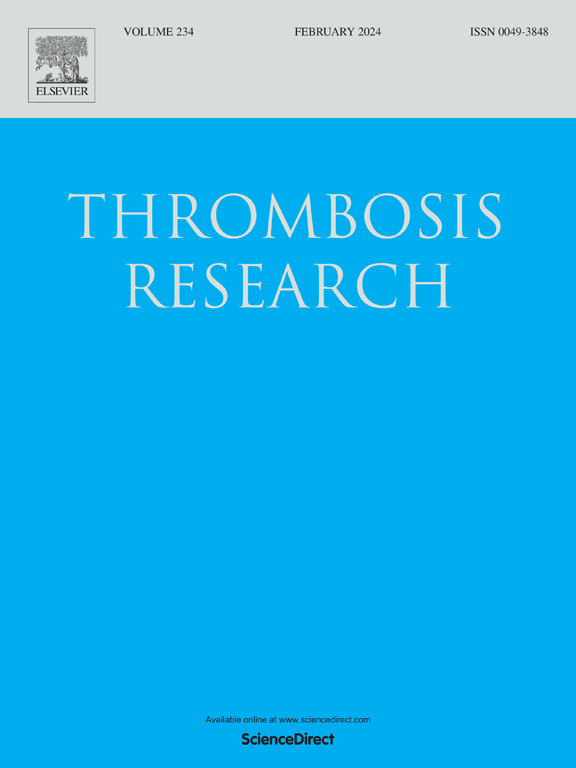Investigation of the impact of antithrombin deficiency on the inflammatory response: Results from a single centre cohort study
IF 3.7
3区 医学
Q1 HEMATOLOGY
引用次数: 0
Abstract
Background
Antithrombin signalling may exert an anti-inflammatory effect; therefore we hypothesised that individuals with inherited antithrombin deficiency (ATD) may have an altered inflammatory state.
Aims
To assess the inflammatory state in those with ATD compared with healthy controls (HCs), by measuring inflammatory markers.
Methods
A case-control study of age- and sex-matched HCs (n = 51) with ATD patients (n = 51). Seven inflammatory makers were selected. ELISA assays quantified: high-sensitivity C-reactive protein (hsCRP), intercellular adhesion molecule-1 (ICAM-1), vascular adhesion molecule-1 (VCAM-1) and complement C3a-des-Arg. Circulating nucleosomes were measured using a chemiluminescence immunoassay (Nu.Q®NETs). Clauss fibrinogen and HemosIL VWF activity were also measured. Results are expressed as median (range).
Results
Overall analysis of ATD vs HCs showed elevated circulating nucleosomes 29.3 ng/mL [0.5–309.3] vs 21.3 ng/mL [3.7–86.3], p = 0.012 but no differences were observed for C3a, VCAM-1, ICAM-1, VWF and fibrinogen. ATD patients were separated into two groups based on the history of VTE. PF1 + 2 levels were decreased in ATD with previous VTE due to anticoagulation. Increased circulating nucleosomes 38.4 ng/mL [11.6–309.3] vs 24.2 ng/mL [9.3–46.5], p = 0.003 and VCAM-1858.3 ng/mL [564.4–2483.2] vs 746.2 ng/mL [460.6–1034.8], p = 0.016 was observed in ATD with previous VTE vs HCs, respectively. Decreased ICAM-1 and VWF levels were noted in the ATD with no history of VTE when compared to HCs. No significant relationships between AT activity and inflammatory markers were found.
Conclusion
Those with ATD did not have an altered inflammatory state as measured by a group of biomarkers except for increased circulating nucleosomes and VCAM-1 compared to paired healthy controls which can be attributed to previous VTE; while those with no personal history of VTE had reduced ICAM-1 and VWF. No correlation was observed between AT activity and levels of inflammatory markers.
抗凝血酶缺乏对炎症反应影响的研究:来自单中心队列研究的结果
抗凝血酶信号传导可能具有抗炎作用;因此,我们假设患有遗传性抗凝血酶缺乏症(ATD)的个体可能具有改变的炎症状态。目的通过测量炎症标志物,评估ATD患者与健康对照组(hc)的炎症状态。方法对年龄和性别匹配的51例ATD患者(n = 51)进行病例对照研究。选取7个炎症因子。ELISA检测定量:高敏c反应蛋白(hsCRP)、细胞间粘附分子-1 (ICAM-1)、血管粘附分子-1 (VCAM-1)和补体C3a-des-Arg。循环核小体采用化学发光免疫分析法(Nu.Q®NETs)进行检测。同时测定Clauss纤维蛋白原和haemsil VWF活性。结果以中位数(范围)表示。结果ATD与HCs的整体分析显示循环核小体升高29.3 ng/mL [0.5 ~ 309.3] vs 21.3 ng/mL [3.7 ~ 86.3], p = 0.012,但C3a、VCAM-1、ICAM-1、VWF和纤维蛋白原无差异。根据静脉血栓栓塞病史将ATD患者分为两组。由于抗凝治疗,伴有静脉血栓栓塞的ATD患者PF1 + 2水平降低。ATD伴VTE与hcc的循环核小体分别增加38.4 ng/mL[11.6-309.3]与24.2 ng/mL [9.3-46.5], p = 0.003, vam -1858.3 ng/mL[564.4-2483.2]与746.2 ng/mL [460.6-1034.8], p = 0.016。与hcc患者相比,无VTE病史的ATD患者ICAM-1和VWF水平均下降。未发现AT活性与炎症标志物之间有显著关系。结论:与配对的健康对照相比,ATD患者除了循环核小体和VCAM-1升高(可归因于既往静脉血栓栓塞)外,通过一组生物标志物测量,ATD患者的炎症状态没有改变;而没有VTE病史的患者ICAM-1和VWF均降低。未观察到AT活性与炎症标志物水平之间的相关性。
本文章由计算机程序翻译,如有差异,请以英文原文为准。
求助全文
约1分钟内获得全文
求助全文
来源期刊

Thrombosis research
医学-外周血管病
CiteScore
14.60
自引率
4.00%
发文量
364
审稿时长
31 days
期刊介绍:
Thrombosis Research is an international journal dedicated to the swift dissemination of new information on thrombosis, hemostasis, and vascular biology, aimed at advancing both science and clinical care. The journal publishes peer-reviewed original research, reviews, editorials, opinions, and critiques, covering both basic and clinical studies. Priority is given to research that promises novel approaches in the diagnosis, therapy, prognosis, and prevention of thrombotic and hemorrhagic diseases.
 求助内容:
求助内容: 应助结果提醒方式:
应助结果提醒方式:


